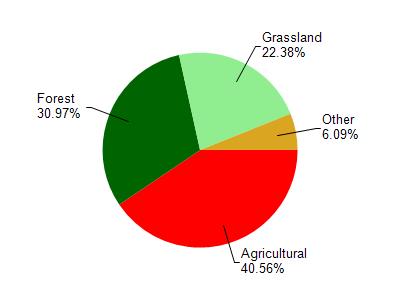
8 Miles
0 - 8
Cool-Cold Mainstem, Cool-Cold Headwater, Coldwater
2025
Good
Dunn
Yes
No
No
Fish and Aquatic Life
Overview
Native brook trout are present throughout Knights Creek and its tributaries. These excellent brook
trout populations are protected by 1.7 miles of fenced streambank. An easement plan has been
approved for the Knights Creek system because of the need to protect and enhance thls native
brook trout fishery and the habitat and water quality of Knights Creek (Holzer 1990).
Date 1996
Author Aquatic Biologist
Condition
Wisconsin has over 84,000 miles of streams, 15,000 lakes and milllions of acres of wetlands. Assessing the condition of this vast amount of water is challenging. The state's water monitoring program uses a media-based, cross-program approach to analyze water condition. An updated monitoring strategy (2015-2020) is now available. Compliance with Clean Water Act fishable, swimmable standards are located in the Executive Summary of Water Condition in 2018. See also the 'monitoring and projects' tab.
Reports
Recommendations
Monitor Water Quality or Sediment
Category 2. 2018 TP Results: May Exceed. Station: 10028742. Au: 15625.
Management Goals
Wisconsin's Water Quality Standards provide qualitative and quantitative goals for waters that are protective of Fishable, Swimmable conditions [Learn more]. Waters that do not meet water quality standards are considered impaired and restoration actions are planned and carried out until the water is once again fishable and swimmable
Management goals can include creation or implementation of a Total Maximum Daily Load analysis, a Nine Key Element Plan, or other restoration work, education and outreach and more. If specific recommendations exist for this water, they will be displayed below online.
Monitoring
Monitoring the condition of a river, stream, or lake includes gathering physical, chemical, biological, and habitat data. Comprehensive studies often gather all these parameters in great detail, while lighter assessment events will involve sampling physical, chemical and biological data such as macroinvertebrates. Aquatic macroinvertebrates and fish communities integrate watershed or catchment condition, providing great insight into overall ecosystem health. Chemical and habitat parameters tell researchers more about human induced problems including contaminated runoff, point source dischargers, or habitat issues that foster or limit the potential of aquatic communities to thrive in a given area. Wisconsin's Water Monitoring Strategy was recenty updated.
Grants and Management Projects
Monitoring Projects
| WBIC | Official Waterbody Name | Station ID | Station Name | Earliest Fieldwork Date | Latest Fieldwork Date | View Station | View Data |
|---|
| 2056800 | Knights Creek | 10009636 | Knight'S Creek Station 4 (350th Ave) | | | Map | Data |
| 2056800 | Knights Creek | 10028742 | Knights Creek At Cth D | 5/21/2008 | 10/16/2016 | Map | Data |
| 2056800 | Knights Creek | 10009667 | Knights Creek 50ft US CTH X -St. 6 | | | Map | Data |
| 2056800 | Knights Creek | 10009631 | Knight'S Creek - Site 5 - 210th St. | | | Map | Data |
| 2056800 | Knights Creek | 10009641 | Knights Creek Station 3 (Cth D) | | | Map | Data |
| 2056800 | Knights Creek | 10009372 | Knights Creek 50ft US STH 72 -St. 2 | 4/23/1998 | 4/23/1998 | Map | Data |
| 2056800 | Knights Creek | 173119 | Knights Creek - Ne1/4 Of Se1/4 Sec.2 | | | Map | Data |
| 2056800 | Knights Creek | 10009639 | Knights Creek Station 1 220th St. | 4/23/1980 | 10/14/2025 | Map | Data |
|

Watershed Characteristics
Knights Creek is located in the Eau Galle River watershed which is 267.88 mi². Land use in the watershed is primarily agricultural (40.60%), forest (31%) and a mix of grassland (22.40%) and other uses (6.10%). This watershed has 519.34 stream miles, 251.50 lake acres and 3,943.12 wetland acres.
Nonpoint Source Characteristics
This watershed is ranked High for runoff impacts on streams, Not Ranked for runoff impacts on lakes and High for runoff impacts on groundwater and therefore has an overall rank of High. This value can be used in ranking the watershed or individual waterbodies for grant funding under state and county programs.However, all waters are affected by diffuse pollutant sources regardless of initial water quality. Applications for specific runoff projects under state or county grant programs may be pursued. For more information, go to surface water program grants.
Knights Creek is considered a Cool-Cold Mainstem, Cool-Cold Headwater, Coldwater under the state's Natural Community Determinations.
Natural communities (stream and lake natural communities) represent model results and DNR staff valiation processes that confirm or update predicted conditions based on flow and temperature modeling from historic and current landscape features and related variables. Predicated flow and temperatures for waters are associated predicated fish assemblages (communities). Biologists evaluate the model results against current survey data to determine if the modeled results are corect and whether biological indicators show water quaity degradation. This analysis is a core component of the state's resource management framework. Wisconsin's Riverine Natural Communities.
Cool (Cold-Transition) Mainstem streams are moderate-to-large but still wadeable perennial streams with cold to cool summer temperatures. Coldwater fishes are common to uncommon, transitional fishes are abundant to common, and warm water fishes are uncommon to absent. Headwater species are common to absent,
mainstem species are abundant to common, and river species are common to absent.
Cool (Cold-Transition) Headwaters are small, usually perennial streams with cold to cool summer temperatures. Coldwater fishes are common to uncommon (<10 per 100 m), transitional fishes are abundant to common, and warm water fishes are uncommon to absent. Headwater species are abundant to common, mainstem species are common to absent, and river species are absent.